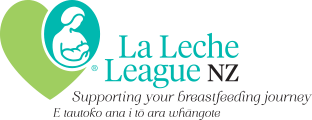Keeping Baby Close at Birth
“Because of health problems developing late in my pregnancy, I must be in hospital for the birth. I’ve read that having my baby as close as possible (skin to skin) at all times is the best way to breastfeeding success but I’m not confident I can do this in a hospital ward. How have other mothers managed to keep their babies close when staying in hospital?”
Responses
Robyn Watkins, Pukekohe – Owing to my recent work with the local maternity hospital – Middlemore – I can tell you that if the hospital you plan to give birth in is accredited under the Baby Friendly Hospital Initiative skin to skin contact between the mother and her baby is always offered and encouraged. At Middlemore it is done as soon as possible after birth and for at least an hour if there are no health concerns. Middlemore also will initiate skin to skin whenever a baby is unsettled or temperature is unstable. Skin to skin contact often leads to baby lead latching.. There are health board pamphlets available and I am sure if this mum talks to her L.M.C and makes it clear she would like this to happen ASAP it will be seen through. Middlemore even encourages and provides for skin to skin contact in theatre after caesarean births and staff will often transport mums in beds from delivery up to the ward with the baby still skin to skin with mum. Lovely to see.
Claire Hargest Slade, Timaru – I think you will be pleasantly surprised at how keen they are for you to have skin to skin contact with your baby. Make sure you write it into your birth plan with who ever will be caring for you. Many mothers have extended periods of skin to skin contact way past the first few hours after birth. There is great evidence to support this practice. Babies are less likely to experience hypoglycaemia and hyperthermia and have lower levels of stress hormones while in direct skin to skin contact with their mothers. They use fewer calories because they are using less energy to maintain their temperature. Midwives all know this, so skin to skin contact will really be at your discretion unless there is a medical reason that it can’t be so. Be assertive about having your intention documented in your notes, and you may well be surprised how well supported skin to skin really is.
Janine Pinkham, Kaiapoi – For mothers concerned about keeping babies close New Zealand is probably the best place in the world to give birth in a hospital setting. Just about all maternity units in New Zealand are now accredited as Baby Friendly. This means that they adhere to the Ten Steps to Successful Breastfeeding. Two of these steps relate to mother and baby togetherness. Step 4 calls for babies (if well) to be placed in skin to skin contact at the time of birth for at least an hour and encourages ongoing skin to skin contact. Step 7 requires “rooming in” where mothers and babies stay together 24 hours a day, just like when you get home. Some facilities even have clip on cots so that babies never need to be more than an arm’s reach away from mum and most facilities encourage mothers to bring their babies into bed with them as long as this is done safely. These and other assistance that supports breastfeeding will help you get to know your baby and get breastfeeing off to a good start.
Lisa, Hibiscus Coast – I had both my babies in hospital, the first in Wellington 19 years ago and the second Tauranga 8 years ago. Both stayed with me skin to skin for at least the first hour and then after being weighed. I was very happy with the way both labours and births went. They were both vaginal births without any interventions. The midwife and my husband knew what my wishes were and supported them. I can’t see why you wouldn’t be able to keep your baby with you at all times in hospital too.
Best wishes for an uncomplicated birth.
